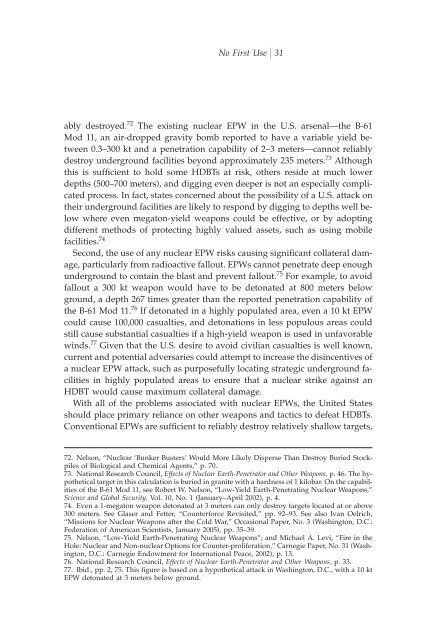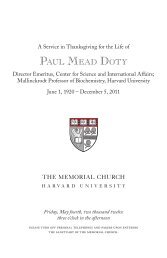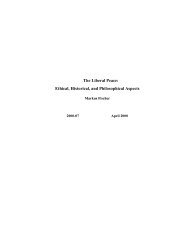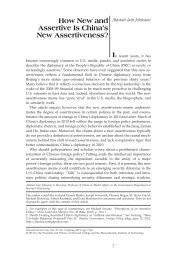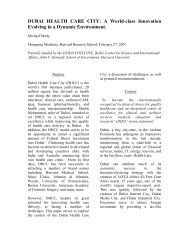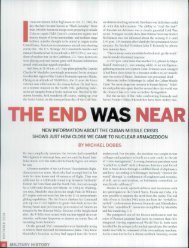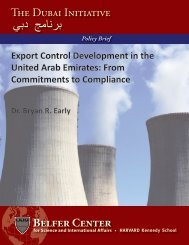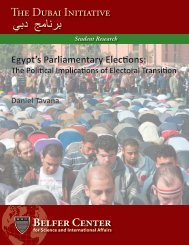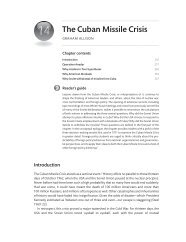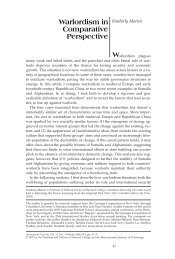The Next Step for U.S. Nuclear Policy - Project MUSE
The Next Step for U.S. Nuclear Policy - Project MUSE
The Next Step for U.S. Nuclear Policy - Project MUSE
Create successful ePaper yourself
Turn your PDF publications into a flip-book with our unique Google optimized e-Paper software.
No First Use 31<br />
ably destroyed. 72 <strong>The</strong> existing nuclear EPW in the U.S. arsenal—the B-61<br />
Mod 11, an air-dropped gravity bomb reported to have a variable yield between<br />
0.3–300 kt and a penetration capability of 2–3 meters—cannot reliably<br />
destroy underground facilities beyond approximately 235 meters. 73 Although<br />
this is sufªcient to hold some HDBTs at risk, others reside at much lower<br />
depths (500–700 meters), and digging even deeper is not an especially complicated<br />
process. In fact, states concerned about the possibility of a U.S. attack on<br />
their underground facilities are likely to respond by digging to depths well below<br />
where even megaton-yield weapons could be effective, or by adopting<br />
different methods of protecting highly valued assets, such as using mobile<br />
facilities. 74<br />
Second, the use of any nuclear EPW risks causing signiªcant collateral damage,<br />
particularly from radioactive fallout. EPWs cannot penetrate deep enough<br />
underground to contain the blast and prevent fallout. 75 For example, to avoid<br />
fallout a 300 kt weapon would have to be detonated at 800 meters below<br />
ground, a depth 267 times greater than the reported penetration capability of<br />
the B-61 Mod 11. 76 If detonated in a highly populated area, even a 10 kt EPW<br />
could cause 100,000 casualties, and detonations in less populous areas could<br />
still cause substantial casualties if a high-yield weapon is used in unfavorable<br />
winds. 77 Given that the U.S. desire to avoid civilian casualties is well known,<br />
current and potential adversaries could attempt to increase the disincentives of<br />
a nuclear EPW attack, such as purposefully locating strategic underground facilities<br />
in highly populated areas to ensure that a nuclear strike against an<br />
HDBT would cause maximum collateral damage.<br />
With all of the problems associated with nuclear EPWs, the United States<br />
should place primary reliance on other weapons and tactics to defeat HDBTs.<br />
Conventional EPWs are sufªcient to reliably destroy relatively shallow targets,<br />
72. Nelson, “<strong>Nuclear</strong> ‘Bunker Busters’ Would More Likely Disperse Than Destroy Buried Stockpiles<br />
of Biological and Chemical Agents,” p. 70.<br />
73. National Research Council, Effects of <strong>Nuclear</strong> Earth-Penetrator and Other Weapons, p. 46. <strong>The</strong> hypothetical<br />
target in this calculation is buried in granite with a hardness of 1 kilobar. On the capabilities<br />
of the B-61 Mod 11, see Robert W. Nelson, “Low-Yield Earth-Penetrating <strong>Nuclear</strong> Weapons,”<br />
Science and Global Security, Vol. 10, No. 1 (January–April 2002), p. 4.<br />
74. Even a 1-megaton weapon detonated at 3 meters can only destroy targets located at or above<br />
300 meters. See Glaser and Fetter, “Counter<strong>for</strong>ce Revisited,” pp. 92–93. See also Ivan Oelrich,<br />
“Missions <strong>for</strong> <strong>Nuclear</strong> Weapons after the Cold War,” Occasional Paper, No. 3 (Washington, D.C.:<br />
Federation of American Scientists, January 2005), pp. 35–39.<br />
75. Nelson, “Low-Yield Earth-Penetrating <strong>Nuclear</strong> Weapons”; and Michael A. Levi, “Fire in the<br />
Hole: <strong>Nuclear</strong> and Non-nuclear Options <strong>for</strong> Counter-proliferation,” Carnegie Paper, No. 31 (Washington,<br />
D.C.: Carnegie Endowment <strong>for</strong> International Peace, 2002), p. 13.<br />
76. National Research Council, Effects of <strong>Nuclear</strong> Earth-Penetrator and Other Weapons, p. 33.<br />
77. Ibid., pp. 2, 75. This ªgure is based on a hypothetical attack in Washington, D.C., with a 10 kt<br />
EPW detonated at 3 meters below ground.


